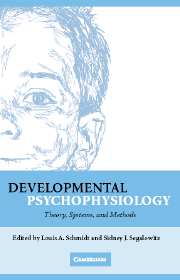Book contents
- Frontmatter
- Contents
- Foreword by Stephen W. Porges
- Preface
- Acknowledgments
- Contributors
- 1 Capturing the Dynamic Endophenotype: A Developmental Psychophysiological Manifesto
- SECTION ONE CENTRAL SYSTEM: THEORY, METHODS, AND MEASURES
- SECTION TWO AUTONOMIC AND PERIPHERAL SYSTEMS: THEORY, METHODS, AND MEASURES
- SECTION THREE NEUROENDOCRINE SYSTEM: THEORY, METHODS, AND MEASURES
- SECTION FOUR DATA ACQUISITION, REDUCTION, ANALYSIS, AND INTERPRETATION: CONSIDERATIONS AND CAVEATS
- Index
- References
1 - Capturing the Dynamic Endophenotype: A Developmental Psychophysiological Manifesto
Published online by Cambridge University Press: 27 July 2009
- Frontmatter
- Contents
- Foreword by Stephen W. Porges
- Preface
- Acknowledgments
- Contributors
- 1 Capturing the Dynamic Endophenotype: A Developmental Psychophysiological Manifesto
- SECTION ONE CENTRAL SYSTEM: THEORY, METHODS, AND MEASURES
- SECTION TWO AUTONOMIC AND PERIPHERAL SYSTEMS: THEORY, METHODS, AND MEASURES
- SECTION THREE NEUROENDOCRINE SYSTEM: THEORY, METHODS, AND MEASURES
- SECTION FOUR DATA ACQUISITION, REDUCTION, ANALYSIS, AND INTERPRETATION: CONSIDERATIONS AND CAVEATS
- Index
- References
Summary
WHY SHOULD DEVELOPMENTALISTS BE PARTICULARLY INTERESTED IN PSYCHOPHYSIOLOGY
Whether we like it or not, those of us interested in psychological development can never get very far away from some form of the nature-nurture question. In general, we have become more careful about ascribing complex behavioral attributes to purely biological substrates or solely to different life experiences. However, often this care is a reflex designed to avoid arguments and not due to true insights. Yet in order to be inclusive, developmental psychologists usually now acknowledge some sources from each, a kind of nature-plus-nurture approach. Some developmental disabilities, however, have often been talked about (depending on the background of the speaker) in terms of either nature or nurture, although most people today would point to both factors. One example is developmental dyslexia, which was originally postulated to have a biological familial basis (Orton, 1937), with various models of cortical insufficiency being blamed (see Pennington 2002, for a review). These insufficiencies include a series of cortical regions noted for their anatomical relation to reading (e.g., inferior parietal lobule), functional modules related to the reading process (e.g., phonological awareness), or sometimes both, such as a model of dyslexia focusing on an anatomically underdeveloped magnocellular system leading to functional deficits that might account for reading difficulties (Stein & Walsh, 1997). Some have suggested polygenic models through twin studies and single gene etiologies through linkage studies (Ingalls & Goldstein, 1999; Meng et al., 2005).
- Type
- Chapter
- Information
- Developmental PsychophysiologyTheory, Systems, and Methods, pp. 1 - 12Publisher: Cambridge University PressPrint publication year: 2007



